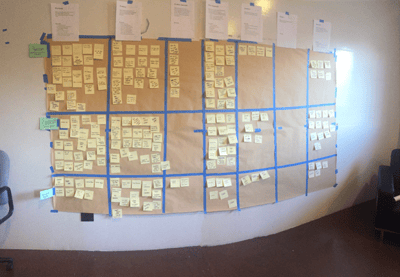Content strategy is a difficult job to explain. I can’t tell you how many puzzled looks I get when I tell someone my job title.
 [“You do content strategy? ...Neat.”]
[“You do content strategy? ...Neat.”]
To help clear confusion, I’ve come up with different ways to describe what a content strategist does (to keep them in my back pocket for times when family members ask about work). Here’s the most recent version:
A content strategist works to understand business goals and user needs, then helps plan, develop, and deliver clear, relevant content that brings the two together.
Here are a few other definitions from seasoned professionals that I look to for guidance. Content strategy is:
“...planning for the creation, delivery, and governance of useful, usable content.”
– Kristina Halvorson, founder of Brain Traffic, and author of Content Strategy for the Web
“...planning for the creation, aggregation, delivery, and governance of useful, usable, and appropriate content in an experience.”
– Margot Bloomstein, principal of Appropriate, Inc.
“... to copywriting as information architecture is to design.”
– Rachel Lovinger, Associate Content Strategy Director at Razorfish
If you really want to learn what content strategy is, a good place to start is learning about what we do. Here are a few key terms, based on some of the main deliverables we produce, to get you started.
Content inventory
A content inventory outlines all the content you have available and notes where it lives on your website.
An inventory is usually created during the initial stages of a website rebuild but should be revisited on a periodic basis. It helps us learn what content we have and where it comes from so we can keep it organized and maintained within the information architecture.
Content audit
To really understand what content is necessary, though, you have to first know how your content is performing. A content audit assigns value to content so you know what’s working effectively, what needs to be updated, and what should be overhauled completely.
Moz sums things up pretty perfectly in their blog on audits:
“Content audits start with taking an inventory of all content available for indexation by search engines. This content is then analyzed against a variety of metrics and given one of three ‘Action’ determinations. The ‘Details” of each Action are then expanded upon.”
What to measure: You can measure your content against industry best practices, competitive benchmarks, strategic business objectives, or all of the above. At the end of the audit, you’ll have a thorough understanding of what content you have and what state it’s in. Ideally, you’ll audit against factors specific to your business and Core Messaging Framework (see this term below), ensuring that not only is your content performing but is also “on brand” as well as furthering your messaging pillars.
What action to take: Action determinations should include the categories “Keep as is,” “Keep and Refresh,” and “Remove.” Detailed descriptions should be included for each action. If you do determine that content should be removed, do your due diligence to look at its SEO profile before making the cut.
Stakeholder interviews
Before embarking on a content project, it’s important to talk to the right project owners and influencers to determine the success metrics for the project. This is typically done through one-on-one interviews with the key project stakeholders. This will result in a clear set of project goals as well as specific content objectives, which will be critical in determining the Key Performance Indicators overall.
Empathy Mapping
The best way to understand a customer’s needs? Understanding them and making them your own. An empathy map is a collaborative tool to help get inside a customer’s head and understand their needs.
To create an empathy map, all you need is a whiteboard or large sheet of paper and an idea of the customer segment you want to understand on a deeper level.
Draw a four-quadrant grid: devote one section to what a customer is hearing, another section to what they’re thinking and feeling, another to what they’re seeing and the final section for what they’re saying and doing. Beneath this grid, create a section to capture pains and gains.
Here’s an example of the grid:
Hearing
|
Seeing
|
Thinking/Feeling
|
Saying/Doing
|
Pains
|
Gains
|
This exercise is a great opportunity for the larger group working on a website to be a part of in order to understand a user and know what a business can offer that’s truly helpful. Empathy mapping can and should be fueled by customer interviews (yep, that means talking to real, live customers).
Keep in mind that an empathy map is not a buyer persona. An empathy map provides emotional information, while a buyer persona shows the behavioral patterns of a prospective customer.
Content gap analysis
A content gap analysis helps determine what new content is needed by figuring out what’s missing. One thing is clear—there’s no shortage of content on the web. That’s why it’s vital to ensure each new piece earns the right to be created, especially considering the time and effort entailed in creating useful, usable content.
One of the best ways to arrive at this analysis is through a web content mapping exercise, where a team reviews a user’s top questions and needs at each point of their journey through the site, then determines what content is available or must be created in order to address the question or need. Lastly, it’s helpful in determining the navigation structure for the holistic site experience, helping them find what they’re seeking, and keeping them engaged longer.
Here’s a handy grid we like to use for setting up a web content mapping session:
| Keywords driving to the site | [A list of keywords the site is currently ranking for, as well as what the site should be ranking for competitively. This list should be pulled before the session.] |
| User questions | [This is where the brainstorming begins. Make a list of any potential questions the user would have at this point in the site. These should be based on keywords and customer interviews, conclusions that can be drawn from website analytics data, and anything else you know about the specific audience. We often like to include subject matter experts that are uniquely familiar with the audience, such as sales staff, customer service team members, etc.] |
| Existing content | [What content exists that can answer these questions? Answers will be informed by the content inventory you performed.] |
| Content needed | [Looking specifically at the questions you’ve uncovered, what content needs to be created? This will make up your content gap analysis.] |
| Forward paths | [What is the main call to action? What next step makes the most sense for a user to take? List them here. TIP: This is where your content objectives really come into play. Be helpful as well as strategic in thinking through your user flows.] |
Repeat this exercise for each part of a customer’s journey or each page of your site, and for each audience segment to determine content gaps and begin planning information architecture for the site.
This is what the output typically looks like:

This is what it feels like:

[Beautiful Mind status.]
Core content models
Content models break down the key pieces of information that must be included in a web page and are called models because they can be applied to the communication design of a group of similar page types. A model lists business goals the page should accomplish, the user needs that should be addressed, inward and outward paths, and the hierarchy of information. In essence, it creates the blueprint for a UX team to create a wireframe and a writer to craft content (they will know the key messages to include).
Core content strategy statement
The core strategy statement is your North Star for creating web content. It should answer the fundamental questions for providing the right content, to the right people, at the right time, for the right reasons, including:
- What content should we produce, procure, curate, and share?
- Who, specifically, is that content for?
- Why do those audiences need or expect that content from us?
- What outcomes does providing this content help us achieve?
Your core content strategy should define content objectives, competitive differentiators, brand values, and voice and tone. Here’s a mad lib, fill-in-the-blank approach from A List Apart:
Every piece of content you create should be in line with the core content strategy. If it isn’t, it doesn’t belong or needs to be revised.
So, that’s a quick overview of the key terms you’ll need to know to understand content strategy.
If you want to learn more about what content strategists do here at LaneTerralever, let us know! We’ve got content strategists ready to help. Take a look at some of our past content work here!




